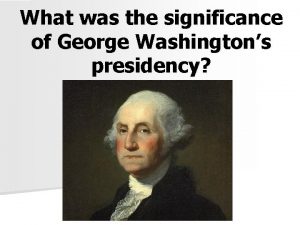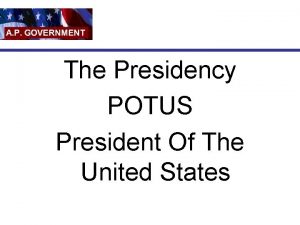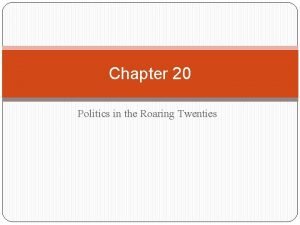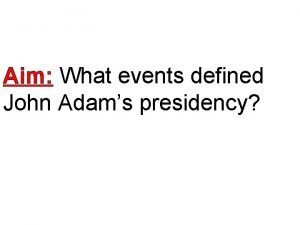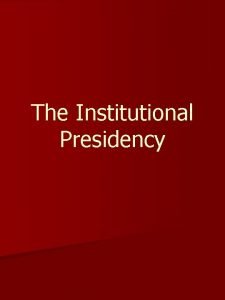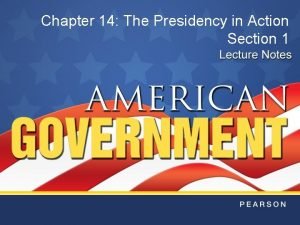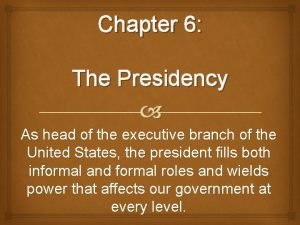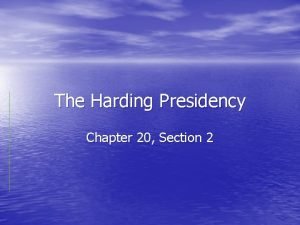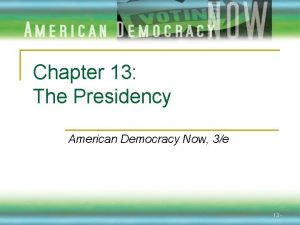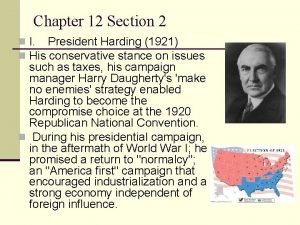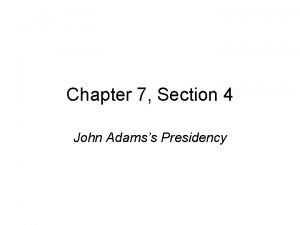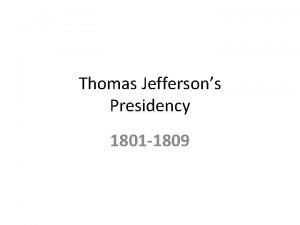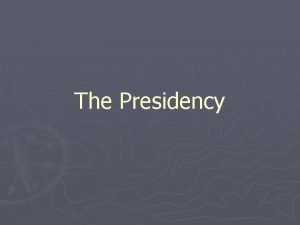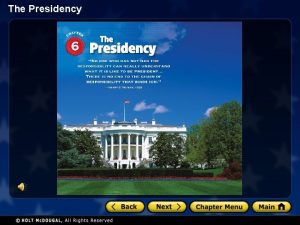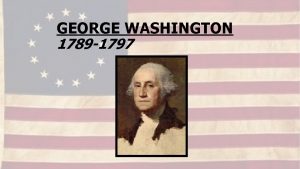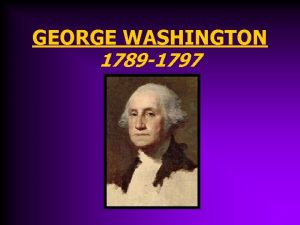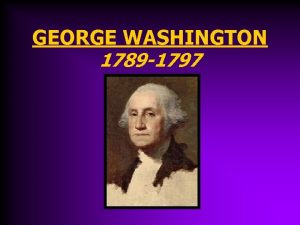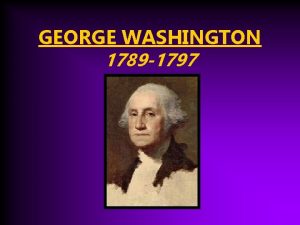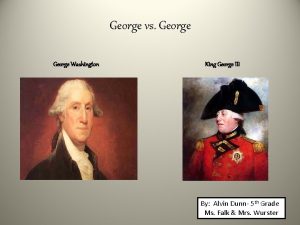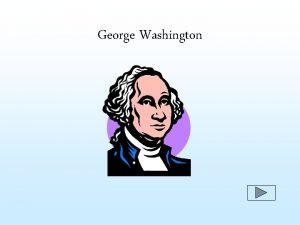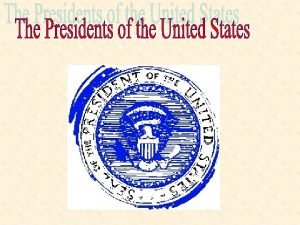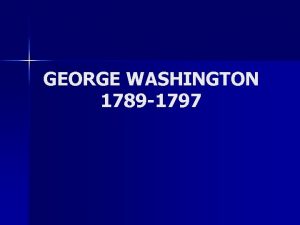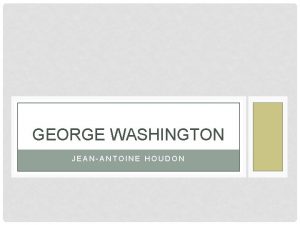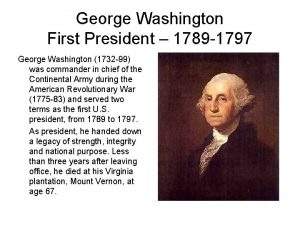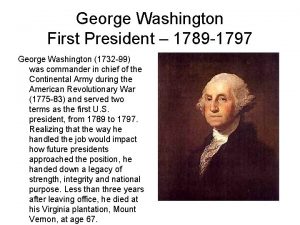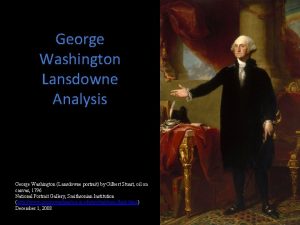The Presidency of George Washington George Washington l
















- Slides: 16

The Presidency of George Washington

George Washington l l 1789 - 1797 No political party affiliation Won 100% of electoral vote in both elections Established precedent of only serving 2 terms as president

Creating the First Cabinet & Establishing the Supreme Court

Alexander Hamilton l Washington’s Treasury Secretary l Wanted to build a financially strong and independent US, especially for American industry and businesses

Thomas Jefferson l Washington’s Secretary of State Former governor, congressman, and ambassador to France l Wanted to protect states’ rights, US-French relations l Resigned from the cabinet in 1793 due to his disagreements with Hamilton l

Henry Knox Washington’s Secretary of War l Tasked with building America’s ability to defend itself l Memorization device: Ft. Knox (in Kentucky) is named after him; forts are used in WAR) l Supposedly died from swallowing a chicken bone l

Edmund Randolph l Washington’s Attorney General l Later became Secretary of State after Jefferson’s resignation, but then forced to resign in 1795, due to scandal; he had been coaching the French government on how to manipulate President Washington, potentially an act of treason

The Judiciary Act of 1789 Passed by the First Congress l Established the Federal Court system l Made clear that the Supreme Court was the highest court in the U. S. l President Washington appointed John Jay to be the first Chief Justice l

John Jay l First Chief Justice (1789 -95) Federalist l Sent to England in 1794 -5 to negotiate Jay’s Treaty (more on that in a later) l Resigned from the court in 1795 to become governor of New York l

Alexander Hamilton vs. Thomas Jefferson

Hamilton’s Economic Plan Most states had many debts left over from the Revolution l Hamilton wanted the US to assume the states’ individual debts l US would pay these debts by taxing whiskey and imported goods l Hamilton also wanted to establish a national bank l

Constitutional opposition to Hamilton’s Plan Thomas Jefferson argued government did not have the constitutional power to create a bank (a strict interpretation of the Constitution) l Hamilton argued that the “necessary and proper” clause allowed the government to do what was necessary to perform its functions (loose interpretation) l

Southern opposition to Hamilton’s Plan Taxes on imported goods would hurt southern farmers l Many southern states had already paid their war debts l South agreed to support Hamilton’s plan only after North agreed to move the capital from New York City to a site on the Potomac River (Washington DC) l

Frontier opposition to Hamilton’s Plan Didn’t like tax on whiskey because that was how many frontiersmen made their living l This opposition led to the Whiskey Rebellion of 1794 l

Whiskey Rebellion Pennsylvania farmers refused to pay whiskey tax and took up arms l Pres. Washington responded by leading the US Army in putting down the rebellion l Federal government demonstrated it could enforce its laws l

Federalists vs. Democratic -Republicans l l l l l Federalists Led by Alexander Hamilton Favored strong national government Favored large landowners and merchants Favored tariffs and government regulations that supported business Loose interpretationists More popular in the North Pro-business Favored neutrality in the war between Britain and France l l l l l Democratic-Republicans Led by Thomas Jefferson Favored strong state governments Favored small farmers Favored a “laissez-faire” approach where government did not regulate the economy Strict interpretationists More popular in the South Pro-farmers Favored France in their war against Britain
 What was the significance of george washington's presidency
What was the significance of george washington's presidency George washingtons presidency
George washingtons presidency George washington vs king george iii venn diagram
George washington vs king george iii venn diagram George washington and thomas jefferson venn diagram
George washington and thomas jefferson venn diagram Presidential line of succession
Presidential line of succession Chapter 20 politics of the roaring twenties
Chapter 20 politics of the roaring twenties What events happened during john adams presidency
What events happened during john adams presidency Which trend characterized thomas jefferson's presidency?
Which trend characterized thomas jefferson's presidency? Institutional presidency definition
Institutional presidency definition Chapter 14 the presidency in action
Chapter 14 the presidency in action Chapter 6 section 1
Chapter 6 section 1 Unwritten qualifications for president
Unwritten qualifications for president Chapter 20 section 2 the harding presidency
Chapter 20 section 2 the harding presidency American democracy now 5th edition
American democracy now 5th edition Chapter 12 section 2 the harding presidency
Chapter 12 section 2 the harding presidency Section 4 the presidency of john adams
Section 4 the presidency of john adams What were president jeffersons economic policies
What were president jeffersons economic policies
